UNLIKELY ALTARS
Where the Sacred Hides in Plain Sight
UNLIKELY ALTAR BLOG POSTS
Some people see ordinary life. Marty sees altars — not the kind made of marble or covered in candles, but the kind you find in casseroles after a funeral, laughter that breaks tension, or conversations that sneak up on your heart.
Unlikely Altars
is Marty’s ongoing reflection on finding grace in unexpected places — from baseball to theology, from grief to gratitude. It’s about the moments that make us pause, laugh, ache, and remember that God shows up everywhere, even in the mess.
Here, faith gets honest, hope gets human, and holiness gets delightfully ordinary.
Pour a cup of coffee, pull up a chair, and join the conversation.
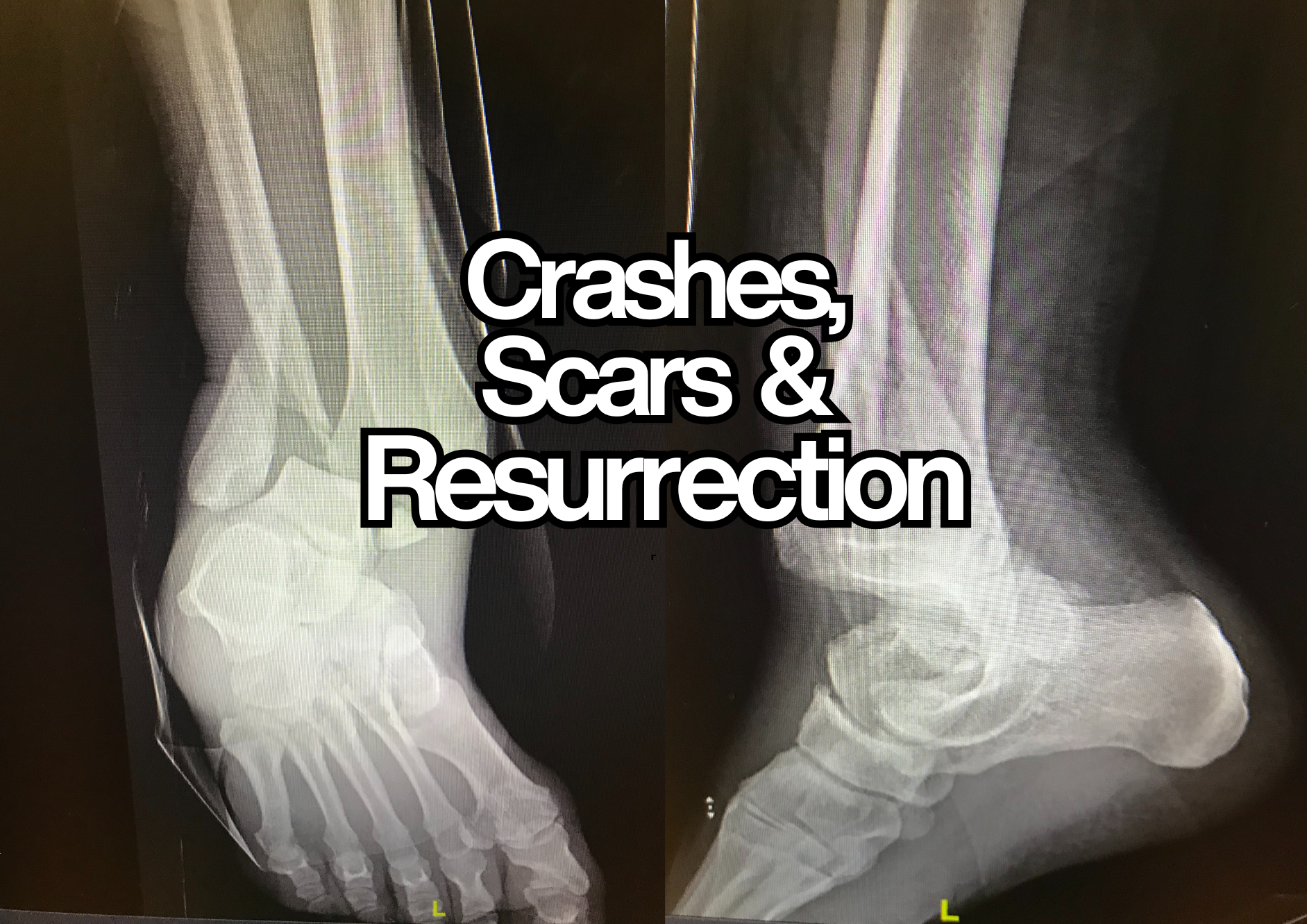
If potholes jar you and gravel unnerves you, crashes just flat-out take you down. Every cyclist knows that sinking feeling: one second you’re upright, the next you’re tangled in a mess of handlebars, chain grease, and pride. Sometimes you get up with nothing worse than road rash. Other times, you limp away with scars that last a lifetime. I know this one by heart. A few winters ago, the Sunday after the Houston big freeze, I was riding the Braes Bayou Trail planning to ride 60 miles before meeting friends for lunch. The pavement looked clear enough, but an innocent-looking patch of slush sent my wheels out from under me. I unclipped but for some reason did it awkwardly, and in a blink my ankle snapped. Just like that, I went from riding free to riding in an ambulance. The 60 miles became 30 miles and the lunch never happened. The aftermath wasn’t pretty. A bunch of screws and plates held my ankle together for a while. My X-rays looked like something from a Home Depot catalog. Eventually, the hardware had to come out because it caused more trouble than it solved. I still keep the X-ray pictures ( the graphics are of my right ankle that was broken ). They’re not pretty, but they preach. Proof that I was broken. Proof that I healed. Proof that sometimes resurrection comes with plates and screws. Today, I carry the memories more than the metal—reminders of both the fragility of the human body and the stubbornness of the human spirit. Life hands us crashes too. The divorce you never saw coming. The diagnosis that stops you in your tracks. The job loss that pulls the rug out from under you. The phone call in the middle of the night that changes everything. Unlike potholes or gravel, these aren’t moments you just “ride through.” They take you down. They hurt. They leave scars. And sometimes they leave you wondering if you’ll ever get back up. Here’s the thing about scars: they don’t lie. They’re honest in a way that words sometimes aren’t. A scar is proof that something hurt you, but it’s also proof that the hurt didn’t win. It tells the whole story—pain and healing, breaking and mending, falling and rising again. Scars are strange that way. They mark the places of our deepest weakness, and at the same time they become signs of our resilience. They whisper both, “This is where you were broken,” and, “This is where you got back up.” My orthopedic surgeon was proud that he’d done the surgeries on my ankle without leaving any visible scars. I told him, half-joking, that I kind of wanted the scars—for the stories, of course. He grinned and said, “Well, I could always draw one on for you.” Without missing a beat, he added, “Then you can just get a tattoo artist to make it permanent.” For a split second, I almost agreed. I can laugh about it now, but the point still stands: scars—real or imagined—carry meaning. They’re proof that you’ve been down, but also proof you got back up. And isn’t that what resurrection really is? Not pretending the crash never happened, but living as proof that it didn’t get the last word. The first ride back after my ankle healed was equal parts joy and terror. My mind kept replaying the fall, reminding me how fragile the body—and confidence—can be. Every turn of the pedal felt risky. Every shadow on the trail looked like another slush patch. But slowly, something shifted. I felt the rhythm again. The tires began to hum. The fear started to fade, replaced by the familiar freedom of the ride. That’s resurrection. Not everything going back to “the way it was,” but the courage to try again after you’ve been broken. Resurrection is about scars that don’t disappear but no longer define you. It’s about grace that meets you in the getting back up. Cyclists trade crash stories the way kids trade baseball cards. Each one carries a mix of pain, pride, and proof of survival. And maybe that’s part of the healing too—learning to laugh at what once felt impossible. I still tell mine with a grin: the slush patch, the screws, the hardware catalog X-rays, and yes—even the surgeon who offered to draw me a scar. Sometimes laughter is its own kind of resurrection. For me, even the crash became an Unlikely Altar. It’s where I was reminded of how breakable we all are—and how much strength we can find in the getting back up. It’s where I learned that scars are more than reminders of pain; they are testimonies of healing. Life’s crashes will come. They’ll hurt. They’ll mark us. But they don’t have the last word. Sometimes they become the very place where resurrection breaks through, where grace shows up, and where we discover that even broken bones—and broken lives—can be made strong again.
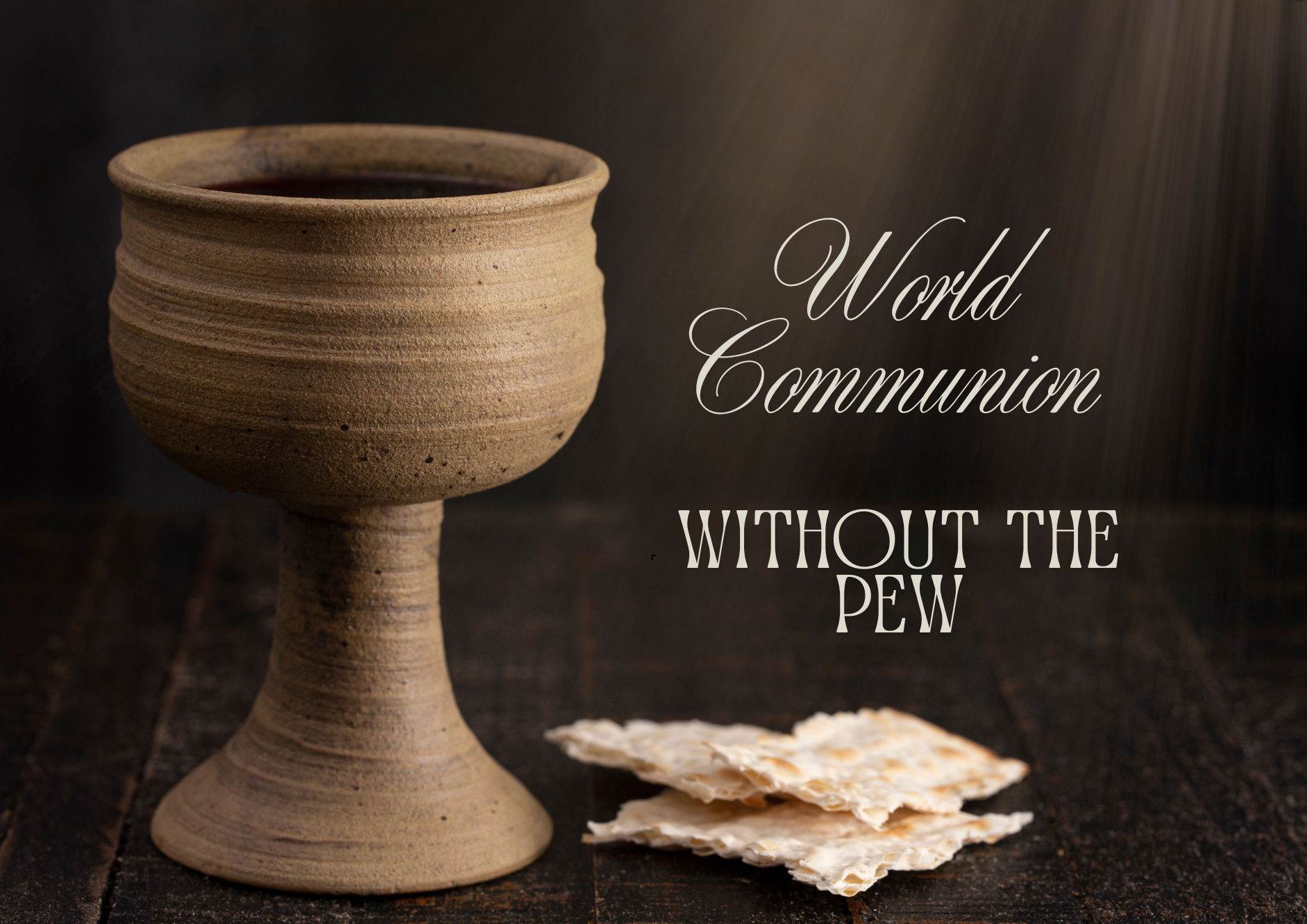
Today is World Communion Sunday. Which means that somewhere, in every time zone and in every language you can imagine, bread is being broken and a cup is being shared. In a cathedral, a golden chalice gleams in the candlelight. In a village, a clay jug is passed under a mango tree. Somewhere it’s pita, somewhere it’s tortilla, somewhere it’s store-brand sandwich bread stacked on a plate from Dollar General. Somewhere it’s juice poured from a crystal cruet; somewhere else, it’s grape Kool-Aid in a plastic cup. And in every place, somehow, grace shows up. That’s the beauty of this day. We don’t all look the same, worship the same, or sing the same. But somehow, across all that difference, we are one table. And even though I won’t be sitting in a pew today, this day still matters to me. Because communion has never only belonged to the altar rail. It shows up wherever bread is broken and barriers are broken down. In casseroles left on a grieving neighbor’s porch, when words aren’t enough but lasagna might be. In coffee shared with someone you thought you’d never forgive. In the chips and salsa that disappear between two friends who haven’t spoken in years, laughter somehow louder than the silence that came before. In a hospital room where a nurse breaks a graham cracker in half and shares it with a patient who hasn’t eaten in days. At a kitchen table, where grace is passed not with liturgy but with a smile, a story, and another helping. Communion is always more than bread and cup. Always more than a line down the aisle. Always more than church on a calendar day. Communion isn’t just vertical, between me and God. It’s horizontal too. It’s what binds us to one another, even in our doubts, our baggage, and our brokenness. It’s why Paul called us “one body.” One loaf. One world. I think that’s what I need to remember in this season: God’s table stretches wider than the walls of any church. Wide enough for my stubbornness, my questions, my wandering. Wide enough for saints and skeptics, doubters and disciples, those who are sure and those who are just hanging on. And communion always points forward. It’s never just about what’s on the table right now—it’s a foretaste of the feast to come. That banquet where nobody leaves hungry, nobody gets left out, and maybe Jesus even does the dishes. That vision gives me hope. A messy, beautiful, stubborn hope. Because let’s be honest: communion has always been messy. There are crumbs on the carpet and fingerprints on the chalice. There are juice stains on white linens and laughter in the line. But that’s exactly what makes it real. Grace isn’t polished; it’s passed hand to hand, smudged with fingerprints, and still holy. That’s what makes it real. So today, even without a pew, I’ll watch for the Unlikely Altars . I’ll look for them in kitchens and coffee shops, hospital rooms and sidewalks, backyard barbecues and breakrooms. Anywhere bread is broken and barriers are broken down. Anywhere grace slips in through the cracks of ordinary life. Because communion is always more than one table. It’s God’s table, stretching as wide as the world. And somehow—by some mystery greater than I can explain—we all fit. The crumbs, the spills, the stubborn questions? They’re not proof we’ve failed. They’re proof that grace has come near. And maybe, just maybe, that’s the communion I need most right now. Maybe it’s the communion many of us need most right now. Maybe that is the true meaning of communion. Maybe that is what the bread and juice are really saying: You belong at the table, even when you doubt. You are part of the feast, even when you feel empty. Grace will m eet you here, crumbs and all.
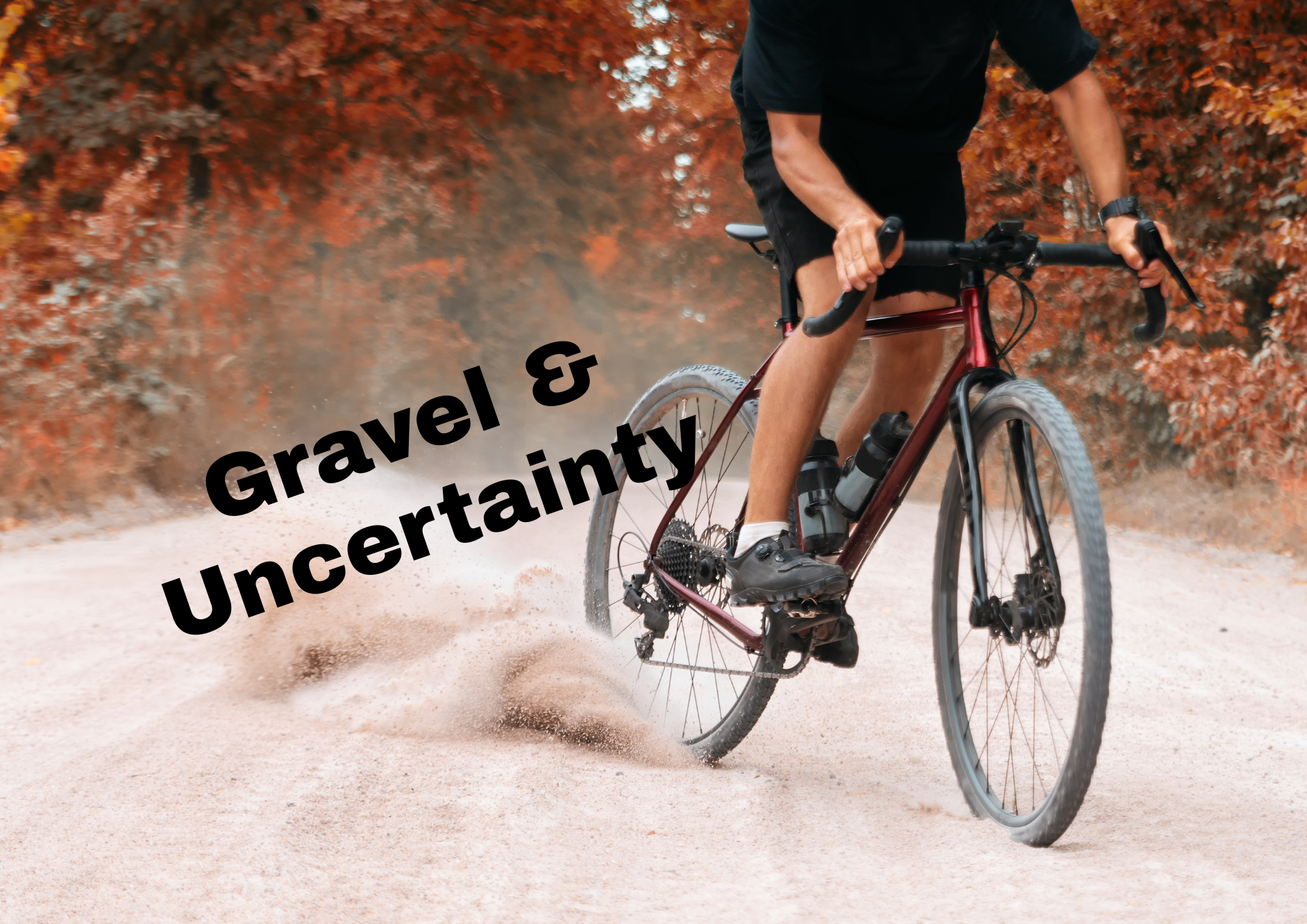
If potholes jar you, gravel just unnerves you. Every cyclist knows the feeling. You roll onto a stretch of loose gravel and suddenly your bike has a mind of its own. The tires skitter. The handlebars wobble. You grip tighter, slow down, and pray you can keep your balance. Even the smoothest ride can turn into a nerve-wracking shuffle when the ground beneath you won’t hold. Life has those stretches too - - the seasons when nothing feels steady. When the GPS of your life suddenly says, “Recalculating…” When the bills keep coming but the paycheck doesn’t. When the path you thought was smooth suddenly shifts under your feet. Gravel moments leave you wondering if you can hold it together. When your road bike hits gravel and starts to slip, the key is to stay relaxed. Tensing up and overcorrecting almost guarantees a crash. The trick is to let the bike move slightly under you, maintain your momentum steady, and make subtle shifts in body weight until you regain your balance. Life asks for the same thing. When the ground feels unsteady - - when the diagnosis isn’t clear, when the job is shaky, when the future feels uncertain - - the temptation is to panic, to overcorrect, to grab the bars of life with a white-knuckle grip. But that only makes the wobble worse. What helps is loosening your grip just enough, trusting that balance can come back, and moving through the uncertainty one steady breath at a time. I once hit a patch of gravel on a bayou bike trail - - a trail I thought I knew well. One second, everything felt fine, the next, I was wobbling like a circus clown. My instinct was to clamp down on the bars until my knuckles hurt. Somehow, I stayed upright. Looking back, I must have looked ridiculous - - half praying, half growling, all nerves. But I made it through. Slowly. Carefully. One shaky pedal stroke at a time. And here’s the thing: gravel often shows up in the most unexpected places. A shoulder you thought was smooth, a bike lane that looked clear - - suddenly it’s loose, unstable, sketchy. One second you’re cruising, the next you’re praying you don’t slide out. Life feels the same way. The uncertainty sneaks up when you least expect it. I’ve felt that same wobble in life. When I was first diagnosed with Sjögren’s Disease, it was like the pavement turned to gravel overnight. The routines I counted on didn’t work the same way. Energy came and went unpredictably. Plans had to be adjusted or abandoned. My instinct was to muscle through. But the harder I pushed, the shakier I felt. And the truth is, it doesn’t matter which part of your life hits the gravel - - your health, your career, your relationships, or your finances. The wisdom is the same: slow down, breathe, and do whatever you can to stay upright. That’s also why I’m writing this. On group rides, gravel isn’t just your problem. If you see it up ahead, the right thing to do is point it out so the riders behind you don’t get caught off guard. A quick finger to the ground, a small gesture - - it’s a way of saying, “Heads up, this could take you down if you’re not ready.” Ride enough shoulders and bike lanes and you learn quickly: loose gravel is everywhere. Calling it out isn’t about being polite - - it’s about keeping people safe. Life works the same way. When you’ve been through uncertain seasons - - health scares, job shifts, grief, or change - - you can point them out for the people coming behind you. Not to scare them, but to say, “You’re not crazy. This road is rough. Slow down. Keep your balance. You’ll get through.” That simple act of looking out for each other? That’s its own kind of grace. Gravel also exposes our illusion of control. On solid asphalt, I can trick myself into thinking I’m in charge. On gravel, I’m reminded just how fragile balance really is. Life’s uncertainties do the same thing. They peel back the illusion and force me to admit: I never had as much control as I thought. And maybe that’s not a bad thing. Maybe that’s the place where trust grows - - not on smooth pavement, but in the loose stones where I learn to lean on something bigger than myself. The good news? Gravel doesn’t last forever . Eventually, the road smooths out. You breathe a little easier. The tires hum again. And when you get there, you don’t take it for granted. You savor it. Life’s uncertainties are like that too. They teach us to slow down, to pay attention, to trust that the uneven stretch won’t last forever. And when stability comes back, we see it as the gift it is. For me, even gravel becomes an Unlikely Altar . It’s where I learn to loosen my grip, to slow down, to breathe. It’s where my prayers sound less like sermons and more like whispers: “God, just get me through this stretch.” And often, that’s enough. The road may still feel shaky, but grace shows up in the very act of staying upright.
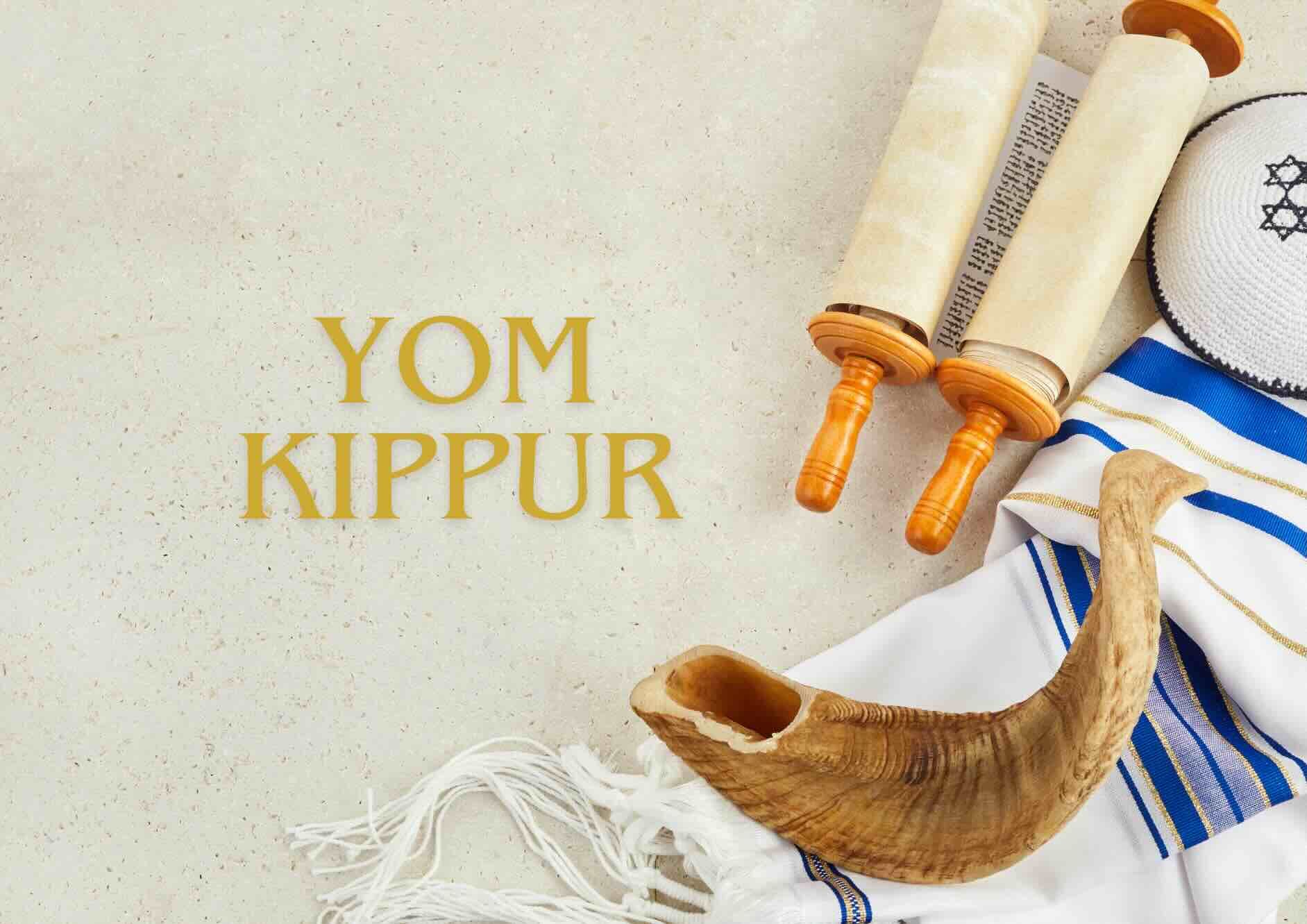
I magine standing in a crowd of hundreds of thousands. Ten days of fasting, soul-searching, and prayer have led to this moment. All eyes turn to one man—the High Priest—who disappears behind a curtain to stand before God on behalf of the people. It’s Yom Kippur, the Day of Atonement. The holiest day of the Jewish year. A day of forgiveness, humility, and a fresh start. But here’s something easy to miss: before the High Priest can carry the sins of the people, he has to reckon with his own. He begins not with the sins of the nation, but with the sins of his own heart. He offers a bull as a sacrifice for himself. He admits his own failures. Even the holiest person in Israel isn’t holy enough to walk into the presence of God without first acknowledging his humanity. And then comes a second striking detail. On this one day, the High Priest takes off his elaborate, jewel-covered vestments—the outfit that signals his status, his sacred role, his authority—and dresses down in plain white linen. Simple clothes. Humble clothes. Human clothes. Can you imagine the scene? After days of fasting and prayer, the crowd holds its breath. The High Priest—no longer dazzling in gold or gemstones, but ordinary, like everyone else—steps into the Holy of Holies. The message is clear: before God, no one comes dressed in status. Only humility. Only honesty. Only as we really are. That moment—the stripping away of status, the exchanging of gold for linen—became its own altar. An unlikely altar. Not the stone altar in the Temple courts, but the altar of humility, honesty, and humanity. That was where the sacred met the ordinary: in the plain clothes of a man admitting he was just like everyone else. And maybe that’s the point. We spend so much of our lives dressing ourselves up—not just with clothes, but with titles, résumés, curated social media feeds, even the smiles we wear when our hearts are breaking. We signal to the world: “I’ve got it together. I’m fine. I’m in control.” But forgiveness and healing rarely come when we’re dressed up. They come when we dress down. When we admit we’ve messed up. When we show up with nothing to hide. When we strip away the roles and the armor and stand there, vulnerable, waiting for grace. I see this again and again in my work. At funerals, grief strips people bare. No one cares about résumés or bank accounts in that moment. What matters are the words left unsaid, the love given—or withheld—and the memories that linger. The sacred comes rushing in, not when we’re polished, but when we’re painfully real. I’ve seen it at weddings too. Beneath the formal clothes and pretty settings, the most powerful moments aren’t scripted. They happen when someone tears up, when a nervous laugh escapes, when the couple realizes this is bigger than their plans. It’s holy, precisely because it’s human. Yom Kippur reminds us that God doesn’t meet us in our perfection. God meets us in our honesty. In our need. In our humility. Tomorrow, Jewish communities around the world will mark the Day of Atonement by fasting, praying, and asking forgiveness—from God, from one another, and maybe even from themselves. For many, it will be a day of deep seriousness. For others, a day of relief, of release, of starting over. But even if you’re not Jewish, the pattern holds: forgiveness, humility, fresh starts. We all need those. We all need moments when we stop pretending we’re fine and admit we’re human. We all need the grace of beginning again. Maybe holiness isn’t found in dressing up, but in dressing down. Not in pretending to be more than we are, but in owning exactly who we are. Because that’s where the unlikely altar waits: not on a stage or in a temple, but in the ordinary, vulnerable moments when we finally get honest enough to let grace in.
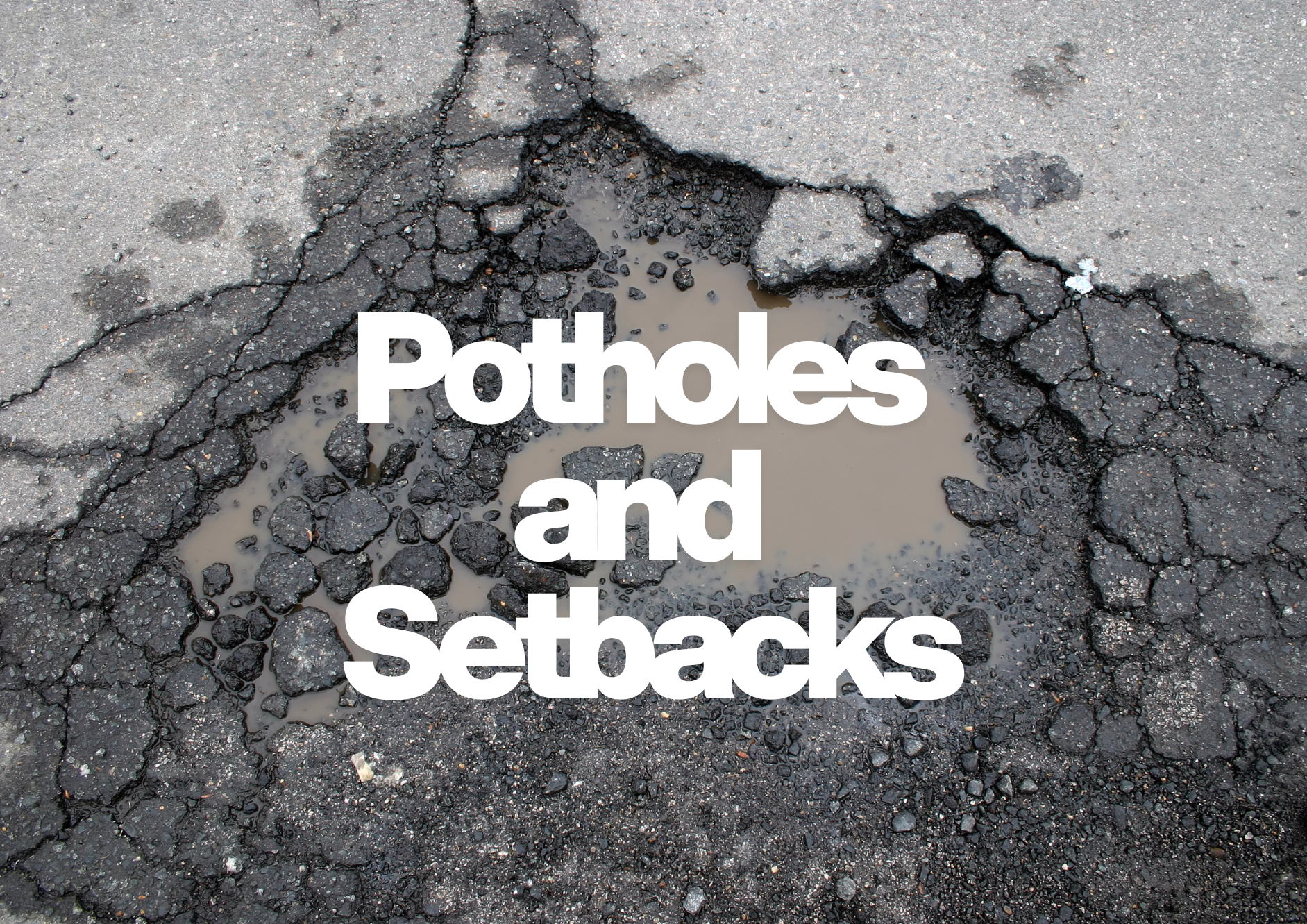
If you ride long enough, you’ll eventually meet a pothole. Sometimes you see it too late and hit it head-on. Sometimes you try to swerve and still clip the edge. Either way, the result is the same: a jolt that rattles your teeth, jars your confidence, and makes you wonder if your wheels are still true. On a bike, potholes are a given. Roads crack. Asphalt crumbles. Weather wears things down. Even the best-maintained streets have weak spots. And the thing about potholes? You almost never hit them when you’re expecting to. They sneak up on you, hiding in the shadows, waiting just past the last curve. Life has its own potholes. The job loss you didn’t see coming. The diagnosis that drops in out of nowhere. The phone call that changes everything. Setbacks jar us the same way a pothole does. They shake our sense of control. They remind us how fragile things can be. And if we’re not careful, they can throw us completely off balance. I remember one ride in EaDo when I let my mind wander. I was in the zone, legs spinning, enjoying the day—and then wham. My front wheel found a crater I hadn’t seen. The jolt nearly knocked me over. I pulled to the side, heart pounding, and checked my bike. The wheel held, but the hit had me rattled the rest of the ride. That’s the thing about setbacks—they echo. After you’ve been jarred, even small bumps make you flinch. It takes time to trust the road again. And I’ve felt that same echo in life. I’ve been blindsided before—times when everything seemed smooth and then suddenly, the bottom dropped out. Ministry shifts I didn’t expect. Friendships that cracked. Health challenges that made me feel more fragile than I wanted to admit. Just like on the bike, those potholes left me cautious, hesitant, scanning the horizon for the next crack in the road. When I hit a pothole on the road, my first reaction is usually not very holy. I grumble about the city workers who should’ve filled it. And if the jolt is especially bad, well… let’s just say a few words come out that you won’t find in the hymnal. But the truth is, we do the same thing in life. Something knocks us off balance, and our first instinct is to point a finger. Sometimes we turn it on ourselves, replaying the “ what ifs ” and “ should haves ” until we’re dizzy. Sometimes we turn it on others, blaming people who hurt us, failed us, or just happened to be standing too close when things fell apart. And sometimes—if I’m honest—we even point it at God, wondering why the road wasn’t made smoother in the first place. Here’s the problem: blame never fills the hole. It doesn’t fix the wheel. It just keeps us stuck, staring at the crack in the road instead of finding a way forward. Blame feels satisfying for about five minutes, but it doesn’t heal anything. What actually helps is taking a deep breath, naming the hurt, learning what we can—and then pedaling on. Here’s something every cyclist figures out sooner or later: if you lock your eyes on the pothole, you’re probably gonna hit the pothole. It’s like your bike reads your mind and says, “Oh, that’s where you’re looking? Great, let’s go there.” And worse, if you stare too long at what you’re trying to avoid, you might miss the car, the curb, or the rider right in front of you. Suddenly, the pothole isn’t your biggest problem anymore. Life works the same way. If all I can see is the setback—the thing that went wrong—I’ll end up running headfirst into it again, or crashing into something else entirely. The better move is to lift my eyes, find my balance, and look for a smoother path forward. Sure, potholes sting. They can bruise your pride or even bend your rim. But they don’t have to end the ride. Looking back, I realize potholes have taught me something important: smooth pavement is nice, but it rarely makes me stronger. It’s the potholes that remind me to stay alert, to pay attention, to appreciate the stretches of road that are even and kind. In life, setbacks can do the same. They teach us resilience, humility, patience. They remind us that perfection isn’t promised, but perseverance is possible. For me, even the pothole becomes an Unlikely Altar. It’s the place where frustration turns into prayer—sometimes an angry prayer, sometimes a desperate one, sometimes a simple sigh. The jolt in the road reminds me that I am not in control, but I am not alone. And somehow, grace shows up in the shaken balance, the deep breath, the steadying of hands on the bars.
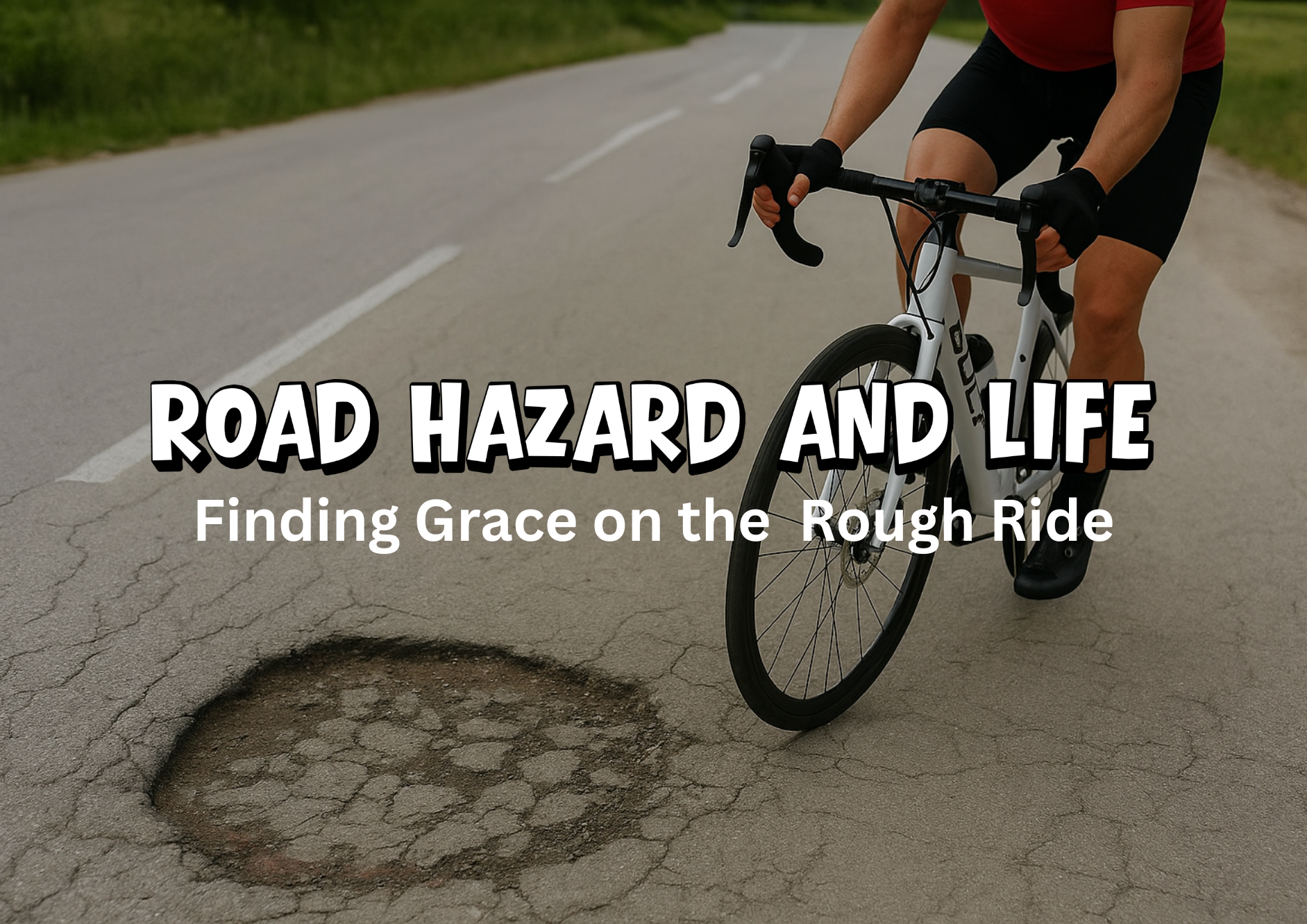
The road is never perfectly smooth. Not when you’re riding a bike, and not when you’re living a life. I love to ride. My Trek Domane road bike isn’t just a machine—it’s my sanctuary on two wheels. There’s something holy about the rhythm of pedaling: lungs filling, legs burning, tires humming on the pavement. On a good day, it feels like prayer in motion. The wind in my face becomes grace I can feel. Out there, the noise of the world fades, and what’s left is rhythm, movement, and presence. But let’s be honest: every ride comes with hazards. There are potholes that sneak up out of nowhere, big enough to swallow a small child—or at least rattle your fillings loose. There’s loose gravel that suddenly turns you into a circus act, wobbling and praying you stay upright. There are dogs who seem to believe it’s their sacred duty to chase cyclists, even when they have no real plan for what they’d do if they caught you. There are squirrels with a death wish, darting across the path like my front wheel is the finish line of their personal Olympics. And there are headwinds—those invisible walls of air that make you wonder if you accidentally signed up for a spin class called Despair on Wheels. And then there are the crashes. I know this one by heart. After a winter freeze, I was riding the Braes Bayou Trail when my wheels found an ice patch. I didn’t unclip quickly enough, and in a blink, my ankle snapped. Seventeen screws and plates later, I had the kind of X-rays that could stop a conversation. For a while, all that hardware held me together. But it also caused its own complications, so eventually it had to be removed. The scars remain, both visible and invisible—a reminder that sometimes the repairs leave their own marks. Still, the bone is stronger for having been broken. And here’s why I’m writing about all this now: I’m finally back on the road. Sjögren’s Disease makes riding harder than it used to be—my body doesn’t always cooperate the way I want it to. But I’ve missed it more than I can put into words. There’s nothing like that moment when I swing a leg over, settle in, and hear the sharp click of my shoes clipping into the pedals. It’s one of my favorite sounds in the world. That little snap always makes me smile, because it means I’m moving again. It means the ride is starting, no matter what the road holds. For me, the bike has become an Unlikely Altar. Not a marble table in a sanctuary, but a frame on two wheels, carrying me down cracked asphalt and winding trails. Each ride is an offering of breath and sweat, joy and pain. The sound of clipping in feels almost sacramental, like lighting a candle or whispering a prayer. Even the hazards—the potholes, the gravel, the crashes, the scars—become part of that altar. They remind me that God shows up not only in smooth pavement, but in the rough patches too. Cyclists learn quickly: hazards are part of the ride. You can’t avoid them all, but you can learn how to face them. And the more I’ve ridden, the more I’ve realized that life works the same way. We all face hazards that throw us off balance: setbacks that jar us, seasons of uncertainty where nothing feels stable, full-on wrecks that leave us scarred, and invisible headwinds that sap our strength. Here’s the truth that keeps coming back to me: hazards don’t mean the ride is ruined. They mean the ride is real. That’s what this series is about. Over the next few weeks, I want to share what the road has taught me about life: Potholes and Setbacks – the jolts that come out of nowhere. Gravel and Uncertainty – when you have to slow down and find your balance. Crashes, Scars, and Resurrection – the wrecks that leave you marked, but not finished. Headwinds and Grace – the invisible resistance that tests your strength and teaches dependence. Cycling strips things down to the essentials. You can’t control the road, the wind, or the dog with a bad attitude. All you can do is keep your balance, keep your eyes ahead, and keep pedaling. Life’s the same way. Smooth pavement is nice, but it’s the hazards that teach us, shape us, and remind us we’re still moving forward. So clip in, take a deep breath, and join me. The road ahead won’t be perfect—but it will be full of grace, laughter, and maybe even a few good stories about dodging squirrels.
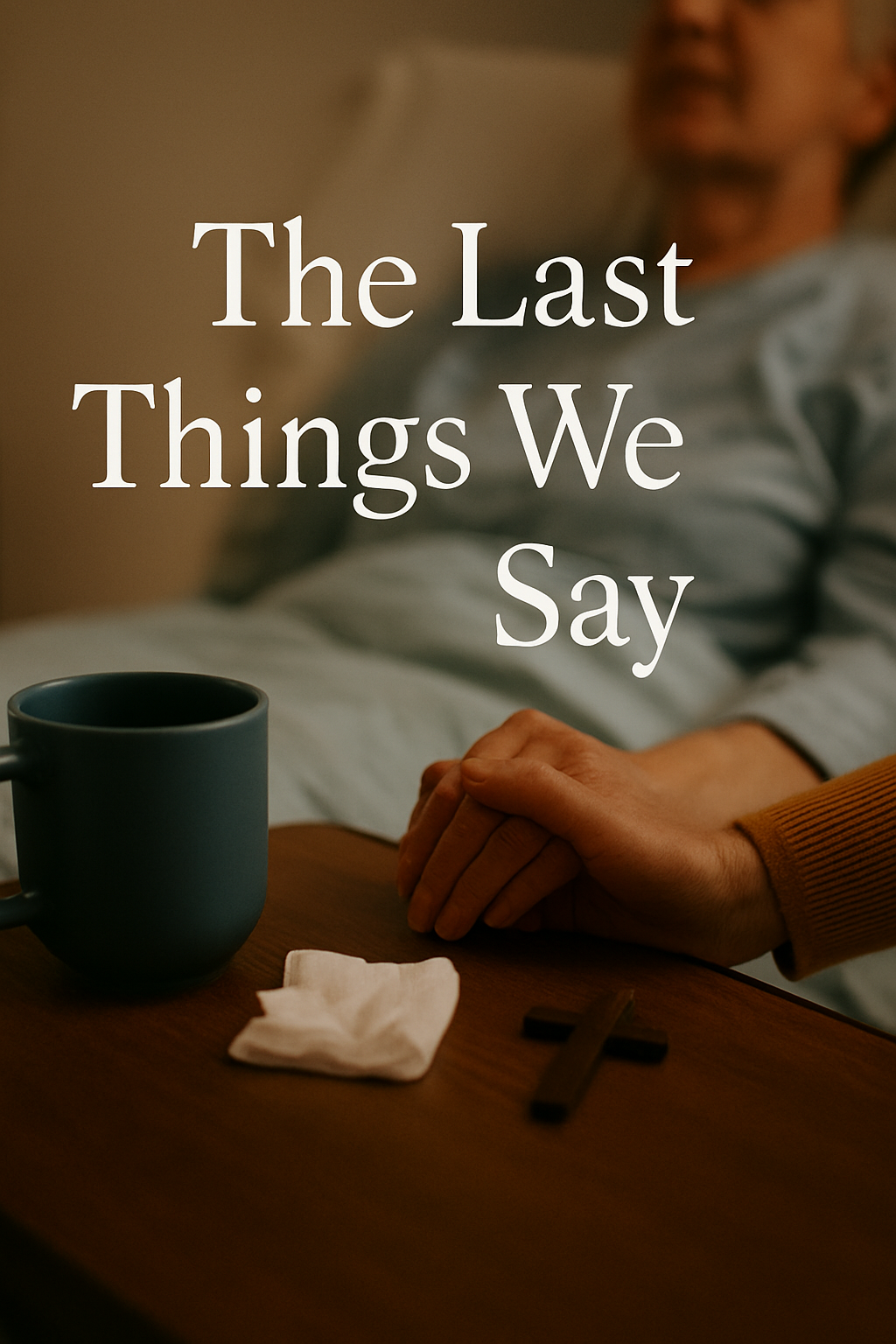
Sometimes, the altar isn’t built of stone. No stained glass. No priest in a robe. Just a hospital room, a folding chair, and the uncomfortable realization that this might be the last real conversation you ever have with someone you love. Not exactly the setting we picture when we think of holiness. And yet—there it is. In one unforgettable episode of THE PITT , the adult children sit at the bedside of their dying father. Someone suggests they tell their dad four simple things. Not a speech. Not a grand gesture. Just four, quiet sentences: I love you. Thank you. I forgive you. Please forgive me. That moment felt like holy ground. No lightning bolt. No choir of angels. But something sacred settled into the air, like grace in street clothes. These four phrases come from the work of Dr. Ira Byock, a renowned palliative care physician who’s spent his life helping people die well—and helping the rest of us not completely blow the chance to say what matters most. In his book The Four Things That Matter Most, Dr. Byock distills a career’s worth of bedside wisdom into a simple but profound truth: when people are dying, what they most need—and what we most need to say—can be boiled down to these four sentences. They don’t fix everything. They don’t erase the past. But they open a door. And often, that’s enough. Dr. Byock’s framework echoes the deeper rhythms of Hoʻoponopono, a traditional Hawaiian practice of reconciliation and restoration. In its original form, families would come together to “make things right” through confession, forgiveness, and mutual accountability—sometimes with the help of a spiritual elder or healer. It was part therapy, part liturgy, part family intervention. The goal wasn’t to win. It was to heal. And isn’t that what we all want in the end? Here’s the part that keeps gnawing at me: Why do we wait until someone’s dying to say the truest things? Why do we save our best words—the vulnerable ones, the ones that crack us open—for the deathbed instead of the dinner table? Why do we think we have time? Maybe those four phrases aren’t just for the dying. Maybe they’re for the living, too. Maybe they’re not only the last things we say — but the things that hold us together all along. Think of them as a kind of relational liturgy. A four-part prayer for love in the real world. I love you - - Not the greeting-card version, but the kind that holds steady through disappointment and dishes left in the sink. Thank you - - A daily practice of naming what we usually overlook. I forgive you - - Not because it’s easy, but because bitterness is heavier than it looks. Please forgive me - - T he most human of all prayers. These aren’t just nice sentiments. They are sacred tools. And most of the time, we forget we’re holding them. So, over the next four posts, we’ll open each phrase like an offering—not just for the dying, but for the living who are stumbling through love and loss in real time. You won’t find case studies or dramatic TV scenes here. Only real stories—the kind that linger, surprise, or quietly change everything. You don’t need a diagnosis to speak these words. You don’t need a priest, a perfect script, or a mountaintop. You just need a relationship worth fighting for. A moment of honesty. And maybe a little courage. Because the sacred doesn’t always arrive in robes and incense. Sometimes it sounds like “I’m sorry,” whispered over coffee. Sometimes it’s a shaky “Thank you” muttered in the car. Sometimes it’s a plain sentence, said just in time. It doesn’t look like much. A sigh. A sentence. A pause. But that’s the thing about Unlikely Altars — sometimes they show up dressed like ordinary life.
